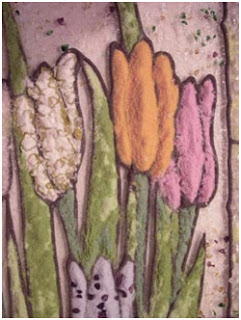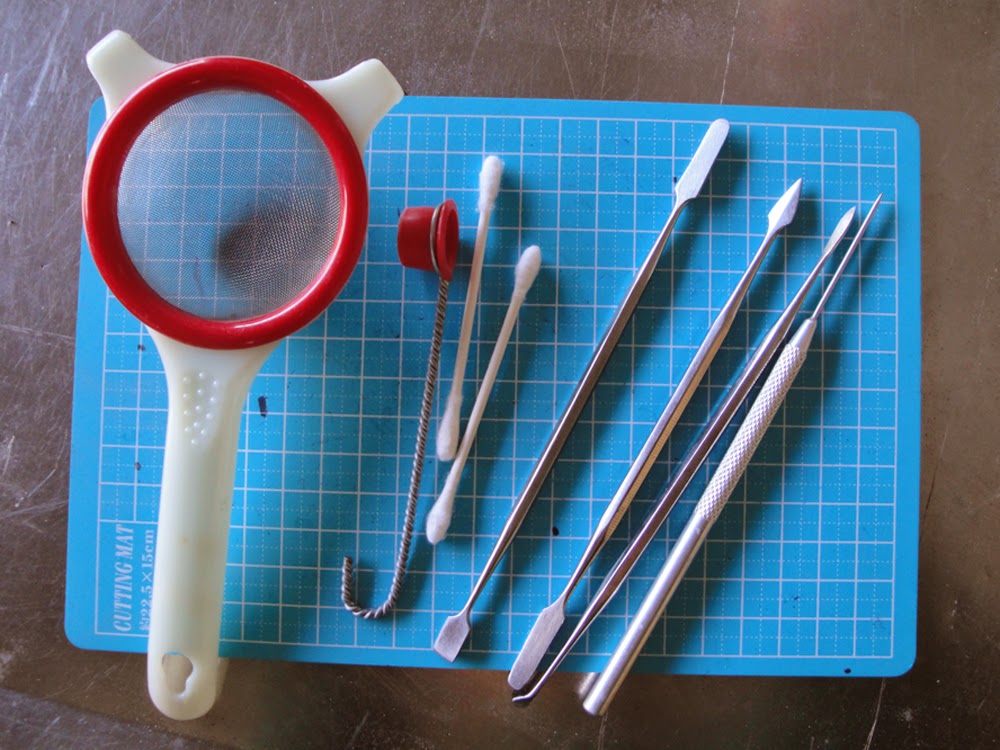Fused glass (and clay)
Fused Glass
Projects
1. Test bottle slump. Double layer, 4X 6X layer squeeze
2. Test phosphorescent powders. Different concentrations by weight, mixes with different color glass powders.
3. Voronoi nonogon
4. Voronoi boat, 2 sided black/white
The specific gravity of Bullseye glass is about 2.5 g/cm3 (41.0 g/in3). This works out to 696.8g/1.53 lb / sq. ft., 4.84g / in2 for 3mm.
Glass idea: Penrose tiling
Glass Frit
Learn how to paint with glass frit, using this excellent tutorial!
4. Mix CMC powder, glass powder and water to a peanut butter consistency.
5. Load the cake decorator
6. Trace out the design on the glass using the decorator
7. Let dry (speed dry with fan or hair dryer)
8. Fill in pattern with glass frit.
CMC powder is used extensively in the food industry. It is a gum additive for thickening products.
The mixing ratio is 9.5 tablespoons of water to 2.5 tablespoons of CMC to 13 tablespoons of glass power. This will make enough for approximately 12 8×10 design.

Day 30 Glass Powder Sgraffito Challenge
” I used a sifter, a business card and a flossing tool to create softer lines in the shading”
“I used my fingers to drizzle powder and then create the lumpy texture on the branch. A q-tip was used to make the softer flowers in the background and a scraper from a scrathboard kit was used for the detailed flowers. A wax carver’s pointy tool made the centers and cleaned up some of the shading.”
“Tools used were my larger sifter, a business card, a scraper from a scrathboard kit, a wax carver’s pointy tool and a q-tip.”
“I drizzled powder with my fingers to create the basic shape and used a business and a wax carver’s metal tool to clean up the lines.”
“I used my sifters, a business card, a scraper from a scrathboard kit, and a q-tip.”
“I did try to use the leaf as a stamp, but I couldn’t get a clean print.”
“Draw apples with a found tool (scraper from scratch board kit), a business card and powder sifters. Also, I used a paper towel to create the texture under the apples, a second found tool.”
“I used the scratching tool that comes with the $1 scratch board kits from Michaels Arts and Crafts store. It worked really well because the tip is slightly curved and allowed the powder to move with the tool rather than just be plowed out of the way. To create my glass drawings I used two sifters, a business card and the scratching tool from a cheap scratch board kit.”
“To create my glass drawings I used two sifters, q-tips and some wax carving tools from harbor freight. The q-tips were perfect for creating the soft edges of the breaking waves. The shaped heads of the wax carving tools were great at moving the powder but when you tap the glass the powder has a tendency to jump slightly.”

Examples
Fused Glass by Full Moon Loon Designs, vid
Lida Dijkstra
Kiln repair / maintenance
Electric Kiln Maintenance with Matt Hoogland (vid)
Clay
The Black Art of Drying Ceramics Without Cracks
Ideas
Make three layers, tack fused. Middle layer contains a maze.
Middle layer contains a sand or something similar, holding in different orientations causes the sand to fall into different slots/patterns, different orientations show different images.
Multiple layers, mostly transparent. Tilting left/right lines up different dots / patches to show different images. How many images are possible?
-Cheery tree / seasons
-person young / old, props / clothes
-nova
Opening flowers
Mount petals on bimetallic strips / open close. Different colors on sides.
Or make the stem a piston, driving the petals open.
Regular tiling, vary colors
Nice tilings: tri/sq 3-unifom tiling, [36; 32.4.3.4], [36; 34.6]2, Deltoidal_trihexagonal_tiling, Tilings chapter
Coating option
Iron pentacarbonyl: patent, thesis using the method
Heat
item to 700C, plunge into bath of near boiling 1% iron pentacarbonyl in
butanol, after a minute pull out, gets a weak pre-coating. Then reheat
1-5 min in 700C, develops color depending on time.
Not clear if coating is opaque or transparent, would need to test.
Making Bubbles
Metal oxides that decompose after glass seals: copper oxide, cobalt oxide, info link.
Also borax (small bubbles), sodium bicarbonate / baking soda / NaHCO3.
Preventing bubbles
Ceramic glaze and bubbles
paper “Production and Testing of Kiln-cast Glass Components for an Interlocking, Dry-assembled Transparent Bridge”, link
Glass clay
Make metal clay, but with glass powder. Here is the metal clay patent: patent.
Ingredients: 50% – 90% metal powder, 0.8% – 8% water-soluble cellulose binder (ethyl cellulose or methyl cellulose), 0.03% – 3% surface-active agent (polysoap or alkylbenzene sodium sulfonate), 0.1% – 3% adhesion-preventing agent (higher organic acid such as phthalic acid, higher organic ester such as di-n-octyl phthalate or di-n-butylphthalate, higher alcohol, higher polyhydric alcohol such as polyvinyl alcohol, polyethylene glycol, and higher ether). Optionally add 2% – 10% ethylene glycol to improve moldability.
Instructions: add methyl cellulose to water, let gel overnight. Add soap, mix in mortar, add metal powder, mix in mortar, add adhesion-preventing agent, mix.
Linear alkylbenzene sulfonic acid. LABSA, 16 oz, $25, Sigma 100g, $21 (or a few drops of laundry detergent?)
Poly vinyl alcohol, 50g, $6
Methyl cellulose, 100g, $9
Polyethylene Glycol, 50 ml, $1
Tessellations
David Bailey’s World of Escher-like Tessellations
Geometry Junkyard–Tilings
Tilings Encyclopedia
Regular n- tessellations
FIGURATIVE TESSELLATION METHOD
Tessellations by Recognizable Figures
Plaster casting
Pâte de Verre with Shin-ichi and Kimiake Higuchi
Art project using unusual methods
Casting example
Casting Glass from 3D Printed Molds
Recycled glass
Tiree Glass
Glass blocks intended for architectural use might be a good source for casting ($2.25 / lb)
Kiln-pressed glass
Firing schedule from Harrach Glass, link
| Segment | Ramp | Target | Hold |
| 1 | 300° F / hr | 1225° F | 3 hours |
| 2 | FULL | 1500° F | 1.5 hours |
| 3 | FULL | 900° F | 2 hours |
| 4 | 100° F / hr | 700° F | none |
Batch glass
Glass typically sold for glass blowing either as mixed ingredients or cullet.
link
Compatability of Glasses, Bullseye TechNotes, link
Casting glass
Gaffer Glass, $17 / lb, link
Firing Schedules
Kiln Firing Schedules
Art Glass Love Firing schedules
fusedglass.org firing schedules
Oceanside firing schedule
Supplies
Boron nitride release, Zyp
Devardi Glass
Holders / Mounting
Seed Packet Plant Markers, 3 / $9
Lampworking tools
Blow Pipe small, 406mm (16″) in length, head flares to 10mm (3/8″) in width and the body diameter of 6.40mm (1/4″), $22
Cold working
Abrasives
Lapidary Polishing Compounds
Cerium Oxide
Our high quality, 85% purity, optically graded cerium, is excellent for polishing glass. One of the best all-purpose polishes. Also used to polish quartz, agate, opal, obsidian, etc
Cerium Oxide 3.5 MICRON SIZE
Cerium-R Oxide 1.2 MICRON SIZELinde ‘A’ Polish
A .3 micron alumina powder that is 99.98% pure aluminum oxide polishing powder with a 9 mohs hardness. A super polish for almost any gemstone.
Mirco Aluminum:
Covington’s Gold Label Polish #1
99% pure micro alumina polishing powder. Excellent for vibrating tumblers, lappers, and ultrasonic machines. Great for Petrified woods, Agate, Rhodocrosite, Jade and other stones. Approximate size 2 – 3 microns and a 9 on the MOHS scale.
Covington’s Gold Label Polish #2
99% pure micro alumina polishing powder. Excellent for vibrating tumblers, lappers, and ultrasonic machines. Works especially well with Leather or Felt. Great for super fine polish on all hard and soft stones. Approximate size .5 microns and a 9 on the MOHS scale.Red Rouge Powder
Inexpensive polish powder used for tumbling. Often used with walnut shell to polish brass. A good final polish for glass and obsidian. Also used with felt belt to polish glass and metals. Red Rouge * 3.5 to 5 MICRON SIZE
Murrini cane in a kiln: The rod mold, 2
Idea:
- To make bubbles in glass, put a chemical that disassociates at a high temperature between two sheets of glass. Barium carbonate (BaCO3), splits at 1360F to CO2 and BaO. At ~1300F-1350F, the glass will tack fuse, locking in the powder, so when it dissassociates, a bubble will form. The BaO may be adsorbed by the glass.
- Add a bit of metal with a high boiling point in a bubble between two glass sheets to make a metalized bubble inclusion. Rubidium (1270 °F), Zinc (1665 °F), Tellurium (1810 °F), Magnesium (1994 °F), Brass (2012 °F), Strontium (1377 °C) and Bismuth (1560 °C) have low boiling points. Put a bit of metal in an bubble between two sheets of glass, and heat to a high temp ~1600F. The metal may get hot enough for some vapor to be released and coat the walls of the bubble. Is it enough to melt the metal, will it wick around? Or is vapor needed?
Draping Molds
stainless steel, 12-18 (2.78 mm – 1.27 mm) gauge, 304 grade
Ring design with clip to open: https://www.delphiglass.com/fusing-molds/stainless-steel-molds/8-round-steel-breakaway-form
Slumping into soft bed
“Straight plaster works but is not infinitely reuseable. At some point, it leaves scum. I make sand mixes that are useable over and over. I start with sand and use about 25% very finely ground alumina hydrate by weight. I started using olivine sand (magnesium sand, (no silica), which disappeared from then market.”
Books
Edward T. Schmid – The Glassworking Techniques books (Beginner and Advanced)
Art of Fire by James McKelvey
Life on the Rails by Steven Ciezki
Glass notes by Harvey Littleton
Techniques
Etch with CO2 laser. Mica will stick to etched regions. Likely work with glass powder and gold foil as well.
Caustic imaging. link.




